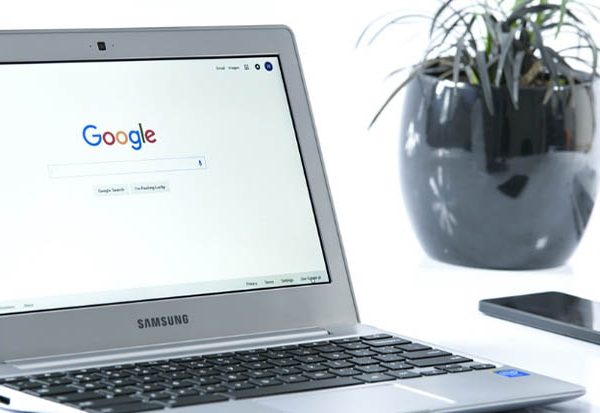The top 6 affordable Chromebooks for distance learning or back-to-school are covered in this article. It may be time to consider Chromebooks if you’re in the market for a new laptop and want something affordable that still performs superbly. You see, Chromebooks are laptops that run Google Chrome OS rather than Windows or macOS as traditional computers do, and they have access to the Chrome Web Store, which is full of apps and tools that can pretty much complete any task. Here are five of the best, most affordable Chromebooks to think about if you’re thinking about purchasing one of these tiny devices. Enjoy!
What Is Chromebooks
A laptop that uses Google’s Chrome operating system is known as a Chromebook. The main distinction is that it depends on internet connectivity even though it has all the features of a typical laptop. In spite of the fact that you can’t install any software on the device, it comes with built-in tools like Gmail and Google Docs to make up for this. Check out our ranking of the top 6 affordable Chromebooks for distance learning or back-to-school if you’re considering purchasing one.
Which Chromebooks For Students Are The Best?
The Samsung Chromebook 4 is a good option for college students on a tight budget. For less than $200 (at the time of writing), this cheap Chromebook provides a high-quality metal lid, snappy performance from its Celeron processor, and lengthy battery life. Due to its light frame, it is also very portable.
Although it may seem confusing that the Samsung Chromebook 2 is superior to the Chromebook 4, it is a good choice for those seeking to upgrade. The Samsung Chromebook 2 is slim, has excellent speakers, a vibrant QLED display, and a long eight-hour battery life. A base model will cost $500, and a top-of-the-line configuration could cost up to $700.
For young students who are still getting used to learning on a laptop, the Lenovo Chromebook Duet is a fantastic option. It has a tablet-like design, a battery life of almost 13 hours, and a passable performance. However, a keyboard is also included for typing. If you need a cheap Chrome tablet with a free detachable keyboard included, it’s still a great investment at $250, and we’re eager to review its replacement, the recently unveiled Lenovo IdeaPad Duet Chromebook.
Affordable Chromebooks For Back To School Or Distance Learning
1. Lenovo Ideapad Duet Chromebook
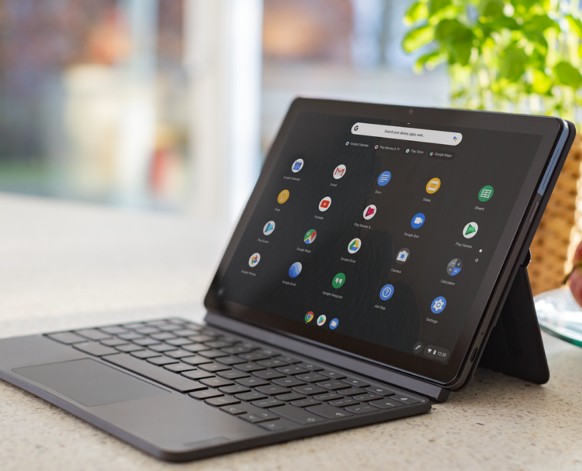
Pros
- Peppy performance
- Handsome design sneaks under 3 pounds
- Responsive keyboard
Cons
- No HDMI port
- Slightly dim display
- Why We Picked It
The Lenovo IdeaPad Flex 5 lacks an HDMI port, like many Chromebooks, so you have to fiddle with a USB-C adapter to connect an external monitor. Otherwise, it’s difficult to find fault with this $549.99 compact; in addition to being a 2-in-1 convertible with a 13.3-inch screen that can be folded and flipped between a laptop and a tablet mode, it also sports an Intel Core i3 processor, a solid-state drive (instead of the more typical smaller, slower eMMC flash storage), lively performance, and limbos under the three-pound mark.
Students who spend some time writing essays and other types of homework, sometimes drawing or writing with a stylus (unfortunately not included), and sometimes tapping and swiping to play Android games will value a convertible that isn’t much heavier than a tablet. The Flex 5 is a great illustration.
2. Asus Chromebook Flip C434
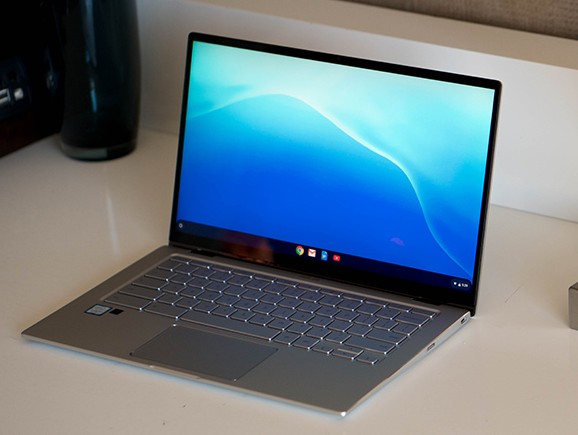
Pros
- Sleek, premium design
- Thin display bezels
- Vivid, 14-inch touchscreen
- Long battery life
Cons
- Finicky touchpad
- A tad pricey
The convertible Chromebook we love has just gotten better. The new Asus Chromebook Flip C434 ($569; reviewed) significantly outperforms its excellent predecessor, the Chromebook Flip C302CA, thanks to a larger display, a longer battery life, and improved performance. Additionally, the Chromebook Flip C434 has a stylish aluminum chassis and a vivid, bright 14-inch display.
The HP Chromebook x2, a 12.3-inch hybrid tablet with a bright display, long battery life, and a comfortable detachable keyboard, is a good choice if you prefer a detachable one and have some room in your budget. Additionally, if you want to save money, the Samsung Chromebook 3 may be the right laptop for you. The Chromebook 3’s $179 price tag is an absolute steal given its lengthy battery life and bright display, even though it doesn’t provide the same performance as the Flip C434.
Overall, the Chromebook Flip C434 is a superb 2-in-1 laptop and the one I would suggest to anyone switching to Chrome OS.
3. Acer Chromebook 314
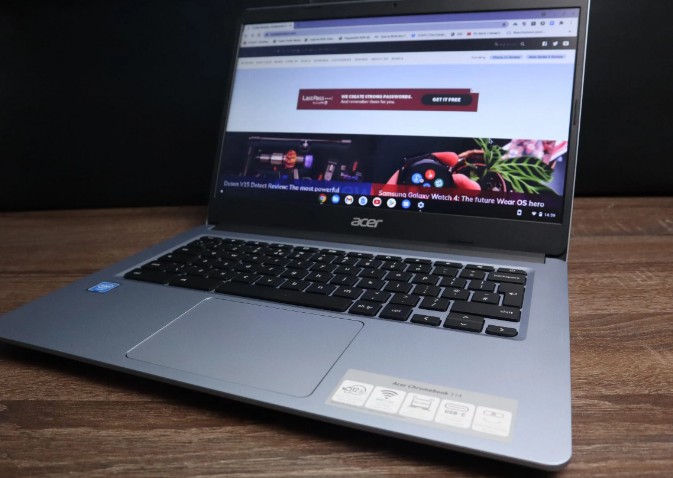
Pros
- Good value for money
- Excellent for blogging and video
- Fantastic battery life
Cons
- Build quality could be better
- We’d prefer a better screen
When looking for a great student Chromebook, you should search for a device that is inexpensive, provides reliable performance, has a fashionable design, and has durability. That combination is perfect on the Acer Chromebook 314.
This is partly because of its Intel Core i5-10210U CPU, which gives Chrome OS a ton of speed (anything faster would be overkill), and 8GB of RAM, which can handle all the Chrome tabs you can throw at it.
Additionally, its 2256 x 1504-pixel screen, which is sharp, produces images that are vivid and bright. Additionally, it completed our web-browsing-based battery test with a runtime of 11 hours and 54 minutes. The 314’s only significant drawback is that it is less portable than some alternatives due to its size. All 13-inch laptops have that problem, to be fair.
4. Google Pixelbook Go
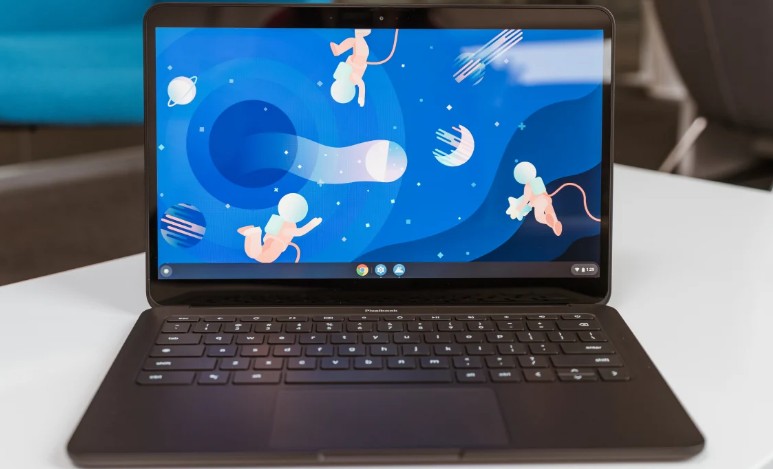
Pros
- Incredible battery life
- Amazing ‘Hush’ keyboard
- Rare 1080p webcam
- Excellent design
Cons
- No biometric login
- Iffy pricing at mid to high end
The Pixelbook Go is a Chromebook, so don’t expect it to perform especially well given that it has fanless Intel CPUs. While we are unable to comment on the performance of the Intel Core m3 in the entry-level model, we can say that the Core i5 Y-series is more than adequate for routine tasks and even some light photo editing.
Additionally, at least with the configurations we’ve tested, the Pixelbook Go’s Geekbench 4 scores aren’t all that much worse than the most recent MacBook Air for its price. That’s quite a feat for a Chromebook, and ironically, quite a feat for the MacBook Air.
In other words, this Pixelbook Go is capable of handling any task we need to complete to carry out our duties here at TechRadar. We do have a varied and intense workload spanning multiple browser tabs and Android apps at any given time, though that does not speak for every user out there.
Since we’ve been using laptops, we can honestly say that the Pixelbook Go has the best balance of silence and feedback. Since the keyboard is so comfortable, we could honestly use this laptop as our primary computer.
5. Dell Chromebook 3100 Education
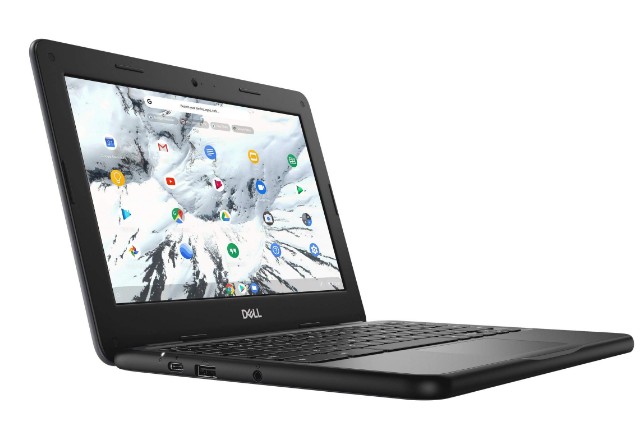
Pros
- Compact
- Sturdy, kid-friendly design
- Spill-resistant keyboard
- Optional LTE
- Plenty of USB ports
- Reasonably priced accidental damage coverage
Cons
- Poor Wi-Fi signal reception
- Display limited to 1,366 by 768 resolution
- No SD card reader
- Clumsy touchpad
The Apple iPad is a great tablet for the classroom, but with the $239 price of Dell’s Chromebook 11 (3100) laptop, good luck finding an iPad plus keyboard cover. For that matter, good luck locating an iPad that can withstand the abuse this robust 11.6-inch system can, thanks to a textured black plastic chassis with rubber bumpers and recessed ports rated to withstand a 30-inch drop onto a steel surface. In addition, Dell says the keyboard can expel 12 ounces of spilled liquid.
There are undoubtedly Chromebooks that are faster and fancier, with larger and better screens (the 1,366 by 768-pixel resolution on the Dell isn’t very good). However, the 3100 is a fantastic choice for a child’s first laptop due to its tough design and low price.
6. Samsung Chromebook Plus V2
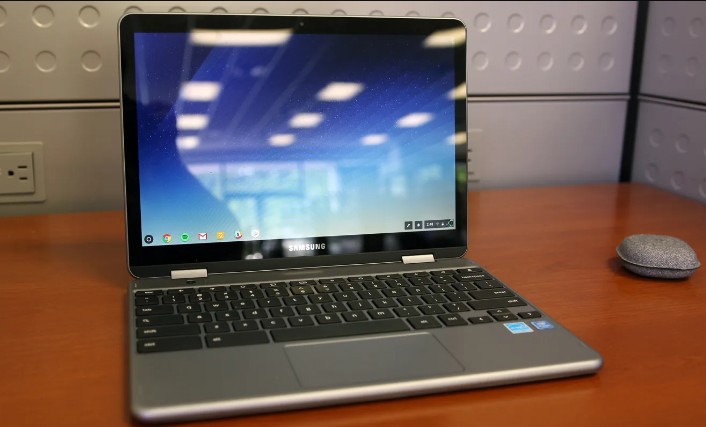
Pros
- Two USB Type-C ports with charging support
- Micro SD Card reader support
- Great for kids due to its construction and durability
- Full HD touchscreen support
- HD Webcam for taking online classes
Cons
- Bulky Chromebook due to its bigger screen
Another reasonably priced Chromebook for back-to-school or online learning is the Samsung-designed Chromebook 4.
It’s a fantastic Chromebook, but don’t compare it to one that costs $1,000 because there are obvious differences in both performance and quality.
However, this Chromebook is ideal for the purpose for which we are looking for one and can help you with anything and everything, including Docs, streaming, surfing, binge-watching, taking notes, completing assignments, and more.
The typical screen size for Chromebooks is 13 inches, but the Samsung Chromebook 4 has a 15.6 inch Full HD touchscreen display.
However, it is just as small and portable as a 13-inch laptop thanks to its thin bezels and small frame.
A sturdy metal case, military-grade construction, and durability make the Samsung Chromebook 4 one of the best laptops for students and children. It can withstand bumps and drops, which is exactly what we need from a laptop for children who are learning online.
What Is The Most Affordable Chromebook For Distance Learning Or Back To School?
Even though a Chromebook can be purchased for less than $100, you should spend at least $400 to ensure a smooth and error-free experience when handling documents, running Android apps, and playing games.
You can easily find the Lenovo Chromebook Flex 5 for the price mentioned, as well as other affordable Chromebooks, in our comprehensive buying guide.
Why Use A Chromebook In Education?
Chromebooks are a popular option for virtual learning for numerous reasons, including that:
- Solid security is offered by them. Sandboxing and Titan C chips are just two of the security features built into the Chrome OS. Additionally, because Chromebooks automatically update, all the applications are always up to date with the most recent security patches. Applications that don’t adhere to the school’s security standards can be restricted using the Google Admin console, according to IT administrators.
- They are portable. Because the Chrome OS requires less powerful hardware, Chromebooks are smaller than typical laptops. They can now be used anywhere a computer is required because they are more portable.
- Education professionals can teach anywhere thanks to the built-in screen recording tool. The Chrome OS (version 89 and higher) has a native screen recording tool that can assist teachers in recording lessons so students can study for tests using recorded sessions. This tool is ideal for online learning settings where it can be combined with resources like Google Classroom and Google Docs to improve learning outcomes.
What Are A Few Negatives Of Using A Chromebook In School?
Although Chromebooks can help facilitate virtual learning environments, they still have their own drawbacks, such as:
- They only have a small amount of storage. The majority of Chromebooks have storage capacities between 16 and 64 GB, which is insufficient to accommodate large files. Google makes up for this by providing 100 GB of unrestricted cloud storage. If you require more storage, you must pay more.
- Only online is when you can sync. Although some Chromebook applications can technically be used without an internet connection, they perform best when connected. For instance, even if your Chromebook is offline, you can still type emails; however, they can only be sent once you are connected to the internet. You can also add a few paragraphs to your assignment, but changes will only be synchronized when the Chromebook is connected to the internet. The majority of programs require an active internet connection, with the exception of a few offline features in a few applications.
- Microsoft applications cannot be fully utilized. Because they are unable to run fully featured services, Chromebooks are not appropriate for students and teachers who adore Microsoft applications. Google encourages users to use its own free, online versions of Microsoft programs like Google Docs and Sheets as well as Android-based apps, but these programs lack the native features that some users may be accustomed to.
- You cannot use additional beneficial Windows-compatible programs. Chromebooks cannot run other Windows-based business productivity software, just like Microsoft applications.
Which Chromebook Is Ideal For Senior Citizens?
Seniors primarily use FaceTime, Webcams, and Zooming on their Chromebooks. Pay close attention to this feature if you plan to purchase a Chromebook for an elderly person.
Additionally, it’s obvious that they enjoy binge-watching Netflix, YouTube, and other streaming services, so the Chromebooks’ displays ought to be of a high standard.
What Is The Ideal Ram Size For A Chromebook?
The recommended amount of RAM for a good Chromebook is 4GB if you use it at home for browsing, zooming, and other similar tasks. However, an 8GB RAM Chromebook is the better choice if you like to multitask.
Since Chromebooks ship with a lightweight version of ChromeOS, they don’t need a lot of RAM to run smoothly.
Zooming And Facetime On Chromebooks Are They Good?
Yes, as you may already be aware, Covid was the main reason Chromebook sales soared in 2020. For Facetime, business meetings, online classes, and a variety of other tasks, people relied on them.
During COVID-19, more people bought Chromebooks than laptops because they have many advantages over conventional Windows or laptops without Windows.
Which Chromebooks Are Ideal For Students?
The Chromebook with the best battery life is the ideal choice for students. It must not be too heavy or bulky, have a good HD Webcam, and be portable.
You don’t need as much hardware for Chromebooks as you would for a typical laptop. Here, ChromeOS allows for faster and more efficient handling of apps and programs.
Can Professionals Also Use Chromebooks?
Yes, if you don’t use your Chromebooks to run resource-intensive Windows apps and programs. You should use a Chromebook because you can install any Android app or game on them.
Professionals can easily perform these tasks on their laptops while browsing, handling documents, taking notes, and performing many other similar tasks.
Chromebooks are fantastic; they can easily handle a variety of tasks for both professionals and everyday users.
Do I Need To Purchase A Convertible Chromebook?
A convertible Chromebook is the only option if you need to use your laptop for note-taking, binge-watching, and reading e-books, blogs, or documents.
Choose a Chromebook with a 2-in-1 design and use it as your normal notebook or turn it into a tablet and use it for anything.
Final Thoughts
The start of the new school year is quickly approaching, so if you’re looking for a cheap Chromebook for in-person or online learning, you can view the list and choose the model that best suits your needs.
We made an effort to select the options that were the least expensive; however, if you have the money, I highly recommend the Google Pixelbook Go. If you prefer a convertible Chromebook, look into the Lenovo IdeaPad Duet Chromebook or the Asus Chromebook Flip C434.
FAQs Of Chromebook
How To Jailbreak A Chromebook With Simple Ways
To Jailbreak A Chromebook, to gain access to useful features, I’ll cover how to jailbreak a Chromebook in this tutorial. Turn off Chromebook > ESC+F3+ Power button > Message Appearing > Ctrl+D > Enter > OS Verification OFF > Enter > Wiping Data Start > Reboot. Read the entire article, to find the details.
Why Does My Chromebook Keep Turning Off
Your Chromebook keeps turning off because of overheating of the system. Chromebooks are designed so that they immediately shut down on their own if the temperature limit is reached.
How To Track A School Chromebook
To Track A School Chromebook, You can create a remote connection between your PC and Chromebook using Google’s Remote Desktop service. You can connect to it from your Windows PC so long as this connection is active (even when you’re using your Chromebook away from home).
As long as you continue to confirm the session on your Chromebook, this remote access session is active. It’s not a perfect solution because each time you take your Chromebook on the go, you’ll need to start the session. Before taking your Chromebook somewhere where there is a high risk of losing it, it allows you to establish a remote connection.
How To Rename A File On Chromebook
The procedure for renaming files on your Chromebook is fairly simple. It will be simple to rename files on a Chromebook if you’ve previously done so on Windows. Although the procedure differs slightly from Windows’s, it is still straightforward.
How To Bypass Administrator On A School Chromebook?
To Bypass Administrator On A School Chromebook, you can try the following steps:
- To turn on the computer, simultaneously press the power, refresh, and Esc buttons. On a Chromebook, the “refresh” button is typically the fourth key from the left, indicated by a swirling arrow.
- Click “d” after pressing “Ctrl.”
- If using a Chromebook, press “space” or the spacebar. In some Chromebooks, you might need to use the “enter” button rather than the spacebar because different models have different key functionalities.
How Much Does It Cost To Fix A Chromebook Screen?
With a do-it-yourself method, a new screen for your Chromebook can cost as little as $23 or $80. Nevertheless, depending on the repair facility you take your Chromebook to, getting the screen professionally fixed can cost anywhere between $200 and $300.
How to Change Time on My Chromebook
To change the time on your Chromebook, just follow the instructions listed below.
Step 1: The notification menu on the home screen or the Settings app in the app menu can both be used to access the Chromebook’s settings.
Step 2: Then choose Advanced, which is the option that is near the bottom of the list to the left.
Step 3: Then select Date and Time, then Time Zone.
You can also enable the 24-hour clock on the same screen
Step 4: Click Choose from list and choose your preferred time zone to manually select the time zone.
Step 4 (alternative): Pick one of the two options (IP address or WiFi network) to determine the location for the time, then click Set automatically to enable the Chromebook to set the time automatically.
How to Set Up Printer to Your Chromebook With Simple Steps?
- Select the time in the lower right corner.
- Select Settings.
- Go to the bottom and choose Advanced.
- Under “Print and scan,” select Printers.
- Under “Available printers to save,” next to your printer, select Save.
- Check that your printer appears at the top, under “Saved printers.”
Try the above steps to set up the printer to Chromebook!
Where is the Refresh Button on a Chromebook?
In most of the Chromebooks, the top row of the keyboard from left to right the fourth button is the refresh button.
How to Connect to Bluetooth to My Chromebook?
Your screen’s bottom right corner contains a Quick Settings Panel button. Click Bluetooth. Choose your Bluetooth device to Chromebook. Follow any additional instructions on the screen.
